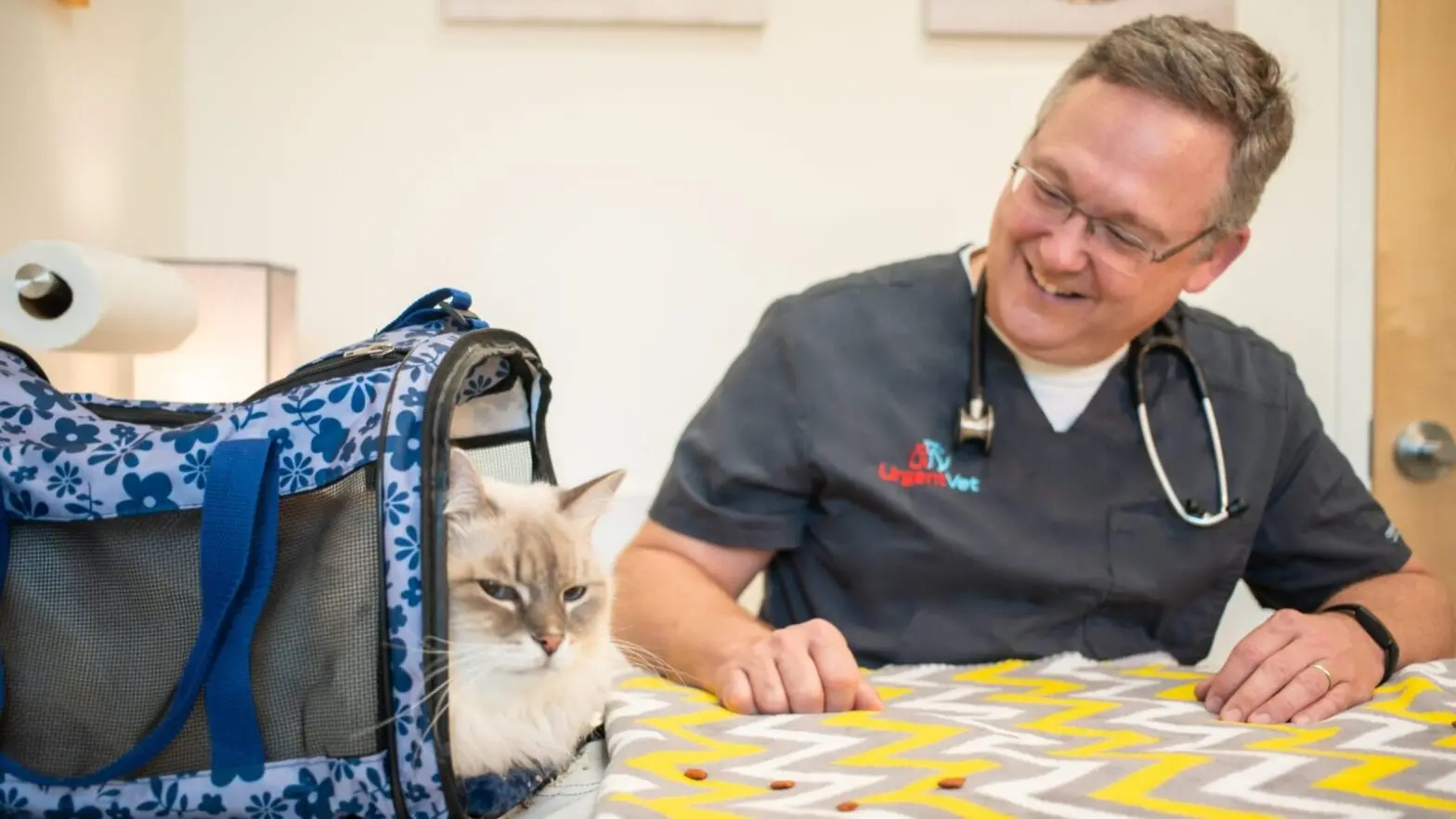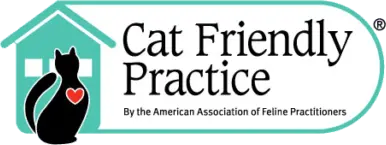Dr. Jim Dobies is a beloved veterinarian and the founder of UrgentVet. While in the waiting room of a human urgent care setting for a condition he had, the idea of the need for the same concept for pets was born. Since then, thousands of pets have been treated at UrgentVet clinics for after-hours injury and illness that’s not serious enough for an ER vet, but that shouldn’t wait until the next day when their regular veterinarian opens.
As a veterinarian, pet parent and animal lover, Dr. Dobies is often asked about conditions affecting cats and dogs. Here are a few of those questions along with Dr. Dobies’ answers.
Question: Dr. Dobies, my dog ate chocolate! What should I do?
Answer: Chocolate is toxic to dogs. Knowing how much your dog ate, and what type of chocolate, is key. Call your veterinarian, an after-hours vet, or the Pet Poison Hotline at 855-213-6680 for immediate advice (there is a fee with the hotline, but it includes a consult with your veterinarian). Your dog’s body weight and how long ago the chocolate was ingested will determine the course of action. It’s important to act fast.
Question: My dog scoots a lot. Usually before going potty. I’ve heard this means her anal glands need attention. Is there any way to tell if this is normal or if there’s a problem?
Answer: Occasional scooting in dogs is a normal cleaning behavior that helps them maintain good hygiene. However, if this behavior occurs every day or several times a day, it’s often due to anal gland discomfort. Some breeds are predisposed to anal gland problems, while other dogs (and cats) suffer from allergies that cause perianal inflammation and itching. Excessive scooting and licking of the region are often the first signs that pet parents notice when there is an anal gland problem. It’s important to have your dog checked by the veterinary staff as soon as possible. If the anal glands are full, the staff can express the material and clean the affected area. You should speak to your veterinarian about how often to have the glands expressed and strategies to relieve inflammation. Long-term, untreated anal gland problems can lead to infections and abscesses, so it’s best to have a routine maintenance plan to keep your dog healthy and comfortable.
Question: Dr. Dobies, I hear a lot about artificial sweetener poisoning. I think it’s called Xylitol. What are some products have it included? What should I do if my dog or cat eats something with this in it?
Answer: Xylitol, sometimes referred to as “Birch Sugar,” is an artificial sweeter found in many sugar-free candies, gum, and mints. Due to its low-calorie nature and good taste, Xylitol is now also showing up in sugar-free baked goods, condiments, jams, and syrups. It’s also a common ingredient in sweet-tasting workout supplements and protein bars as well as diet soft drinks and sugar-free beverages. Perhaps least well known, Xylitol is also a common sweetener in human dental products like toothpaste and mouthwash, and it can even be found in human medications like cough syrup and children’s liquid formulations. Xylitol is extremely toxic to dogs even in small amounts. It can cause dangerously low blood sugar (hypoglycemia), seizures, liver failure, and death. If you suspect that your dog ingested any product with Xylitol, call your vet immediately. You can also call the ASPCA Animal Poison Control hotline at 888-426-4435. Be prepared with the item(s)/product(s) ingested, amount/quantity, and your dog’s weight.
Question: How do I know if my pet has ring worms? What should I look for?
Answer: Ringworm is not actually a worm at all. It’s a fungal infection that in people has a circular (ring-shaped) appearance on the skin, can be red and scaly in appearance, as well as itchy. Affected dogs and cats can be difficult to diagnose because their thick fur coats obscure the appearance of the skin rash. It’s important to note that people can acquire ringworm via three different routes: first, from another infected person, particularly young children that attend daycare and/or school; second, from the environment, often moist environments like locker rooms; and finally, from companion animals like kittens and puppies (cows, goats, pigs, and horses can also spread ringworm). If your dog or cat has itchy skin, your veterinarian can perform a couple of simple tests to rule out ringworm. If your pet does have ringworm, a combination of topical therapy (shampoo) and oral medication can be used to treat them effectively. Your vet will also have safety recommendations to limit your exposure. The good news is that ringworm in people is usually mild and self-limiting. If you develop the characteristic rash on your skin, it’s always best to consult a physician.
Question: Why does my dog drink a lot of water? Should I be worried?
Answer: Like people, pets drink water according to several factors. The most common causes of extra water ingestion are dehydration, exercise, and increased dietary salt. In these normal circumstances, the body knows it needs more water, so the pet drinks more to compensate. However, if you notice a profound daily increase in water consumption and none of the aforementioned factors have changed, then it’s wise to have your pet checked out by your veterinarian. Conditions such as heart disease, kidney disease, and endocrine (hormonal) disease can result in unusually high water consumption. In fact, increased thirst can be one of the first symptoms noted by pet parents. Early detection of these conditions is the key to successful management. Don’t hesitate to mention to mention a change in water consumption to your vet during annual and semi-annual wellness visits as your pet ages.
Question: Dr. Dobies, as Easter season is nearing, I wanted to ask about lilies. I’ve heard they’re toxic to cats and dogs. Is this true? Should I keep them out of the house all together?
Answer: In a word, yes. However, Easter Lilies are potentially fatal to cats, while they may only cause mild GI irritation if ingested in large quantities by dogs. According to the Pet Poison Helpline, all parts of the Lily plant (flower, leaves, stem, and pollen) are toxic in cats. Ingestion of even a small amount can lead to severe kidney failure. If you have a cat, it’s best to avoid lilies altogether. For dog owners, I recommend limiting dogs’ access to all houseplants. Many species of plants are not specifically toxic but can cause vomiting or diarrhea if consumed in large amounts.
Question: Is it OK to put my pet in a costume on Halloween?
Answer: If your pet is used to wearing clothes, it’s likely that they’ll be tolerant of a costume. However, anything a pet wears needs to allow them to see, hear, breathe (sniff), walk, and go to the bathroom normally. If you’re considering a Halloween costume for your pet, a dry run a few days before Halloween is a good idea – to see how they respond.
In addition, Halloween can be a confusing time for pets. Trick-or-treaters coming to the door and walking through active neighborhoods can be stressful. Watch for cues and be certain that your pet is properly secured. Ensure that he or she has access to water if you live in a warm climate. Finally, be mindful to keep all candy out of reach.
Question: Dr. Dobies, I’m having a pretty large gathering at Thanksgiving. My pets sometimes get a little nervous when we have visitors. Any tips for helping with this?
Answer: The holidays are a wonderful time of year for families. There’s good food to eat, lots of togetherness, and time off to enjoy each other’s company. Generally, pets enjoy this time too, but there can be added anxiety related to unfamiliar people, places, and routines. If your pet has a safe place in the home, like their crate or dog bed, make sure it’s in a quiet place where they can have some privacy. If you don’t have a safe place set aside, now is a good time to establish that routine before the guests arrive. Make sure it is comfortable and large enough for the pet to lay down to sleep. It’s also helpful to be able to darken the room and play soft music or white noise to minimize triggering stimuli. If your pet suffers from anxiety, talk to your veterinarian about prescription medications, herbal remedies, and other strategies to help keep them calm.
Question: Dr. Dobies is it dangerous to let my dog play with sticks? He loves them but I worry they’ll get lodged in his mouth or throat.
Answer: Chewing is a natural and desirable behavior in dogs. The act of chewing is an enrichment activity and has the benefit of helping to keep dogs’ teeth clean. The important things to monitor are what a dog is chewing on how long they are permitted to chew. Extremely hard items can damage teeth and gums. High value treats like beef bones can be eagerly consumed whole and lead to GI obstructions. Treats like sticks and softer bones can splinter and become lodged in the mouth, esophagus, or further down the GI tract. I recommend sticking to chew toys that are somewhat pliable but do not easily break apart (e.g., Nylabones and Kong Toys). If your dog is a heavy chewer, monitor the activity carefully and take away the item after 10 or 15 minutes to give your dog a rest. If any chewed item is destroyed, pick up the pieces immediately and dispose of them safely.
Question: Anything I need to be mindful of when taking my dog to the beach, lake or river? With summer coming soon, we want to include our pets but we also want them to be safe.
Answer:It’s fun to travel and have adventures with our dogs. I recommend speaking to your veterinarian about special risk factors associated with your local environment. Your vet will discuss vaccinations, de-worming, heartworm preventatives, flea and tick preventatives, and any special health considerations for your breed of dog. Generally, anyplace that it’s safe for a human to go is also safe for your dog. However, physical activity should be performed in moderation and access to shade and clean drinking water are a must. Have fun but take frequent breaks.
Watch this space for more questions and answers impacting the well-being of pets.





